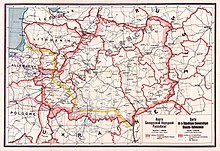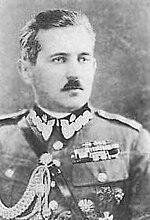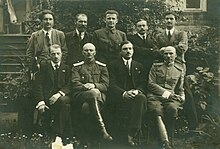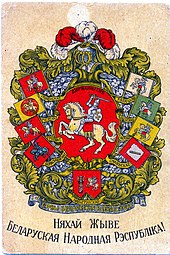Belarusian Democratic Republic
You can help expand this article with text translated from the corresponding article in Russian. (October 2020) Click [show] for important translation instructions.
|
Belarusian Democratic Republic Беларуская Народная Рэспубліка Bielaruskaja Narodnaja Respublika | |||||||||||||||
|---|---|---|---|---|---|---|---|---|---|---|---|---|---|---|---|
| 1918–1919 Exile: 1919–present | |||||||||||||||
| Anthem: Ваяцкі марш Vajacki marš " President of the Rada | | ||||||||||||||
• 1918 | Jan Sierada | ||||||||||||||
• 1918–1919 | Jazep Losik (acting) | ||||||||||||||
Mikoła Abramčyk | |||||||||||||||
• 1970–1982 | Vincent Žuk-Hryškievič | ||||||||||||||
• 1982–1997 | Jazep Sažyč | ||||||||||||||
• 1997–present | Ivonka Survilla | ||||||||||||||
| Legislature | Rada | ||||||||||||||
| Historical era | World War I | ||||||||||||||
• Established[1] | 6 March 1918 | ||||||||||||||
• Independence proclaimed | 25 March 1918 | ||||||||||||||
• Disestablished | Spring 1919 | ||||||||||||||
• In exile | 1919–present | ||||||||||||||
| Currency | Ruble | ||||||||||||||
| |||||||||||||||
The Belarusian People's Republic[2][3][4] (BNR; Belarusian: Беларуская Народная Рэспубліка, romanized: Biełaruskaja Narodnaja Respublika, БНР), or Belarusian Democratic Republic, was a state proclaimed by the Council of the Belarusian Democratic Republic in its Second Constituent Charter on 9 March 1918 during World War I. The Council proclaimed the Belarusian Democratic Republic independent in its Third Constituent Charter on 25 March 1918 during the occupation of contemporary Belarus by the Imperial German Army.[5]
The government of the Belarusian Democratic Republic never had power over the whole territory of Belarus. In 1919, it co-existed with an alternative
Currently, its government in exile, the
Name
In some historical documents, the White Ruthenian Democratic Republic phrase was used initially.[8] In the current scholarship, Belarusian Democratic Republic and Belarusian National Republic names dominate.[9][10] The Rada BNR uses the Belarusian Democratic Republic name.[11] It also appears in the publications originating in Belarus.[12] The Belarusian People's Republic appears in publications,[13] however, its use is comparatively limited, e.g. it does not appear in the titles of scholarly publications.
History

This section needs additional citations for verification. (March 2017) |
After the 1917
Parallel with negotiations that started between the Germans and Bolsheviks, the Belarusian Council started actively demanding recognition of autonomous status for Belarus, with continuing internal discussions on whether it should become an autonomous region within Russia or declare national independence.
On 21 February 1918, the German army captured Minsk. On the same day, the Belarusian Council passed the First Constituent Charter declaring the council the only legitimate power on the territory of Belarus. Neither the occupying authorities, nor its government in Berlin, however, were interested in the idea of an independent Belarusian state.[14]: 26
On 3 March, Germans and Bolsheviks signed the
On March 25, 1918, the All-Belarusian Congress proclaimed the independence of the Belarusian People's Republic (Bielaruskaja Narodnaja Respublika, abbreviated as BNR). The Government of the BNR left Minsk in December 1918 for the Lithuanian Republic, and in the spring of 1919 went into exile.[15]
Territory
In its Third Constituent Charter, the following territories were claimed for BNR:
Military

There were attempts to create an
According to the historian
General Stanisław Bułak-Bałachowicz supported the Government of the People's Republic and openly positioned his army as a Belarusian national army.
The major military action of the Army of the People's Republic was the
Foreign relations
During its short existence, the government of Belarus established close ties with the Ukrainian People's Republic, organized food supplies to Belarus from Ukraine and thereby prevented hunger in the country.[19]
Beginning in 1918,

In 1919, a delegation of the Belarusian People's Republic under Prime Minister
In October 1919 the Belarusian People's Republic was officially recognized by Estonia and in December 1919 by Finland.[22][23] On November 11, 1920, the Belarusian People's Republic signed a treaty with the government of Lithuania in which both states declared to recognize each other and to cooperate together.[24]
Other actions

The government also managed to create between 150 and 350 schools and preparations for the creation of a university in Minsk were initiated.[25]
Exile
In December 1918, the German army retreated from the territory of Belarus and the
In 1925, the exiled Rada of the Belarusian Democratic Republic (Rada BDR) discussed relinquishing its authority in favor of the
During
The advance of the Red Army in 1945 forced the BNR's Rada to relocate to the western part of Germany, occupied by British and American troops. In February 1948, the Rada passed a special manifesto, by which it declared its return to activity. In April 1948, the Rada, together with deputies of the Belarusian post-war refugees, held a conference in Osterhofen, Bavaria.
After the dissolution of the Soviet Union in the 1990s, similar governments-in-exile of the neighboring countries (Lithuania, Poland and others) handed back their mandates to the corresponding independent governments.
Upon declaration of independence of the
The Rada BNR still exists as a
Since the late 1980s, March 25, the Independence Day of the Belarusian Democratic Republic, is widely celebrated by the Belarusian national democratic opposition as Freedom Day (Belarusian: Дзень волі). It is usually accompanied by mass opposition rallies in Minsk and by celebration events of the Belarusian diaspora organizations supporting the Belarusian government in exile.
Symbols

A national flag of three stripes –
-
10-hrašoŭ postage stamp
-
25-hrašoŭ postage stamp
-
A postage stamp of the Belarusian Democratic Republic
Presidents
Chairpersons of the
- Jan Sierada (1918)
- Jazep Losik (1918–1919; acting)
- Piotra Krečeŭski(1919–1928)
- Vasil Zacharka (1928–1943)
- Mikoła Abramčyk(1944–1970)
- Vincent Žuk-Hryškievič (1970–1980)
- Jazep Sažyč (1980–1997)
- Ivonka Survilla (1997–present)
Archives
In 1998, Belarusian linguist and translator Siarhiej Šupa published a two-volume collection of BNR archives (Архівы Беларускай Народнай Рэспублікі. Менск-Вільня-Прага-Нью-Ёрк). The total size of the two volumes is more than 1700 pages. Essentially these are the processed and re-organized documents from the Lithuanian archival fund #582 in Vilnius and they constitute roughly 60% of all the BNR official documents from 1918. Another 20% of BNR official documentation is located in the Minsk archives, and the fate of the remaining 20% is unknown.
See also
References
- ^ Druhaja Ŭstaŭnaja Hramata da narodaŭ Bielarusi [The Second Constituent Charter to the Peoples of Belarus]. (n.d.). Retrieved December 29, 2017, from http://www.radabnr.org/usthramaty/hramata2/
- ISBN 9780244767938.
- ISBN 9781443875196.
- ISBN 9783319665238.
- ^ Treciaja Ŭstaŭnaja Hramata Rady BNR [The Third Constituent Charter of the Council of the BNR]. (n.d.). Retrieved December 28, 2017, from http://www.radabnr.org/usthramaty/hramata3/
- ^ Ladysieŭ, U. F., & Bryhandzin, P. I. (2003). BNR: stanaŭliennie, dziejnasć. Ministerstva bielaruskich spraŭ pry Litoŭskaj Tarybie [BNR, its formation and activities. The Ministry for Belarusian Affairs under the Council of Lithuania]. In Pamiž Uschodam i Zachadam. Stanaŭliennie dziaržaŭnasci i terytaryjaĺnaj celasnasci Bielarusi (1917–1939) [Between the East and the West. The formation of statehood and territorial integrity of Belarus (1917–1939)] (pp. 84–88). Minsk: Belarusian State University.
- ^ Ladysieŭ, U. F., & Bryhandzin, P. I. (2003). BNR: stanaŭliennie, dziejnasć. Ministerstva bielaruskich spraŭ pry Litoŭskaj Tarybie [BNR, its formation and activities. The Ministry for Belarusian Affairs under the Council of Lithuania]. In Pamiž Uschodam i Zachadam. Stanaŭliennie dziaržaŭnasci i terytaryjaĺnaj celasnasci Bielarusi (1917–1939) [Between the East and the West. The formation of statehood and territorial integrity of Belarus (1917–1939)] (pp. 117–119). Minsk: Belarusian State University.
- ^ Michaluk, Dorota (2009). "Przebieg granicy białorusko-litewskiej w propozycjach działaczy BRL 1918-1919" [Lithuanian-Belarusian border in the proposals of Belarusian People's Republic politicians 1918-1919]. Europa Orientalis (in Polish) (1): 462 – via Lituanistika.
Petition presented by the Delegation of the Government of the White Ruthenian Democratic Republic
- )
- OCLC 1240724890.)
{{cite book}}: CS1 maint: location missing publisher (link - ^ "Rada of the Belarusian Democratic Republic". Archived from the original on 2017-09-08. Retrieved 2021-08-30.
- OCLC 842905808.
- OCLC 41140236.
- ISSN 0075-4161.
- ISSN 0075-4161.
- ^ "3rd Constituent Charter of the BNR Rada". The Belarusian Democratic Republic official web site. Retrieved 15 March 2017.
- ^ a b "Selected Bibliography of works on the struggle for Belarusian Independence 1900–1921 in the Francis Skaryna Belarusian Library in London". The Belarusian Democratic Republic official web site. Archived from the original on 27 September 2013. Retrieved 15 March 2015.
- ^ "25 пытанняў і адказаў з гісторыі БНР" [25 questions and answers on history of BNR] (in Belarusian). Euroradio.fm. 24 March 2014. Archived from the original on 12 September 2015. Retrieved 15 March 2015.
- ^ Сергей Крапивин (24 March 2009). "Баба с красным обозом перед "Европой"" [A woman with a red baggage in front of "Europa"]. Naviny.by. Archived from the original on 2 April 2015. Retrieved 15 March 2015.
- ^ Анатоль Грыцкевіч [ Anatol Hrytskievich ]. "Яго імя – сімвал нашай незалежнасці" [His name is the symbol of our independence] (in Belarusian). Zbsb.org. Retrieved 15 March 2015.
- ^ "Чатыры ўрады БНР на міжнароднай арэне ў 1918–1920 г." [Four governments on international Arena in 1918–1920] (in Belarusian). Archived from the original on 2013-07-03.
- ^ Päewauudised. Walge-Wene saatkond Tallinas. / Julius Seljamaa // Waba Maa, 20.10.1919. p. 3.
- ^ Helsinki, jouluk. 16 p. Suomi tunnustanut Walko-Wenäjan hallituksen. / Santeri Ivalo // Helsingin Sanomat.: – Helsinki: 16.12.1919. – № 341. – p. 3.
- ^ Тихомиров А. В., Library BY (January 3, 2006). "Дипломатия БНР в период послевоенного обустрйоства Европы и польско-советской войны (ноябрь 1918 г. – март 1921 г.) (КУЛЬТУРА И ИСТОРИЯ БЕЛАРУСИ)". http://portalus.ru, Library.BY – via library.by.
- ^ "95th anniversary of BNR" [The Belarusian People's Republic was declared on March 25, 1918.]. charter97.org. Retrieved 24 September 2017.
- ^ Уладзімер Арлоў (11 May 2006). "Васіль Захарка". Радыё Свабода (in Belarusian). Radio Free Europe/Radio Liberty.
- ^ "The March 20, 2006 Memorandum of the BNR Rada". The Belarusian Democratic Republic official web site. 20 December 2010. Retrieved 15 March 2017.
Further reading
External links
- The Rada of the Belarusan Democratic Republic in Exile website
- "The sorrows of Belarus: A government in exile, a country in a mess". The Economist. 16 November 2006.
- "Europe.view Heart of darkness". The Economist. 13 March 2008.
- Timeline of Belarusian People's Republic





